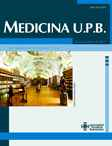Caracterización de las reacciones adversas a medicamentos reportadas al programa de Farmacovigilancia de un hospital de alta complejidad y factores asociados con su evitabilidad
Contenido principal del artículo
Resumen
Objetivos: caracterizar las reacciones adversas a medicamentos reportadas al programa de Farmacovigilancia de un hospital de alta complejidad entre 2009 y 2012 e identificar los factores asociados con su evitabilidad.
Metodología: estudio observacional, transversal, basado en los reportes de reacciones adversas notificados al programa de Farmacovigilancia. Se realizó análisis univariado para las variables cualitativas y para las comparaciones se calculó el Chi-cuadrado de independencia. El tamaño de muestra estimado con una potencia del 80% fue de 84 casos.
Resultados: se reportaron 2.973 reacciones adversas a medicamentos en 2.531 pacientes con frecuencia similar en ambos sexos y una edad media de 41.7 años (DE 24.42). Los antibacterianos sistémicos y los analgésicos son los grupos terapéuticos más reportados (28.76% y 19.44%, respectivamente). La piel y apéndices fue el sistema corporal más afectado (47.1%). Las reacciones moderadas y graves representan el 88.7% de las reacciones reportadas y el 9.4% fue evitable. Se encontró asociación significativa entre la evitabilidad y los medicamentos de alto riesgo, los antecedentes alérgicos, si la reacción fue considerada la causa de ingreso al hospital y la edad de los pacientes.
Conclusiones: los resultados obtenidos son comparables con otros estudios y permitieron identificar factores susceptibles de intervención para promover el uso seguro de medicamentos; la identificación de factores asociados con la evitabilidad, algunos no reportados hasta ahora, constituye un hallazgo importante en la búsqueda de estrategias de minimización de errores prevenibles.
Referencias
World Health Organization. International drug monitoring: the role of the hospital. Geneva, Switzerland: World Health Organization; 1966.
Juntti-Patinen L, Neuvoren PJ. Drug-related deaths in a university central hospital. Eur J Clin Pharmacol. 2002; 58:479–482.
Jimmy J, Padma GM. Pattern of adverse drug reactions notified by spontaneous reporting in an Indian tertiary care teaching hospital. Pharmacol Res. 2006; 54:226–233.
Lazarou J, Pomeranz BH, Corey PN. Incidence of adverse drug reactions in hospitalized patients: a meta-analysis of prospective studies. JAMA. 1998; 279:1200–5.
World Health Organization. Medicines: safety of medicines – adverse drug reactions. Geneva: World Health Organization; 2008.
American Society of Health System Pharmacists. ASHP guidelines on adverse drug reaction monitoring and reporting. Am J Hosp Pharm. 1989;46:336–7.
Alvarez-Requejo A, Carvajal A, Begaud B, Moride Y, Vega T, Martin Arias LH. Under reporting of adverse drug reactions. Estimate based on a spontaneous reporting scheme and a sentinel system. Eur J Clin Pharmacol. 1998;54:483–8.
Lobo MG, Pinheiro SM, Castro JG, Gomes V, Pranchevicius MC. Adverse drug reaction monitoring: support for pharmacovigilance at a tertiary care hospital in Northern Brazil. BMC Pharmacol Toxicol. 2013;14:5
Gallelli L, Ferreri G, Colosimo M, Pirritano D, Guadagnino L, Pelaia G, et al. Adverse drug reactions to antibiotics observed in two pulmonology divisions of Catanzaro, Italy: a six year retrospective study. Pharmacol Res. 2002;46(5):395–400.
WHO Collaborating Centre for Drug Statistics Methodology. Completed ATC Index 2013 [monografía en Internet].Geneva: WHO; 2013 [citada 2013 Ene 5]. Disponible en: http://www. whocc.no/atc_ddd_index/
Institute for Safe Medications Practices. ISMP´s list of high alert medications [monografía en Internet].. Horsham, PA: ISMP; 2013 [citada 2013 Feb 28]. Disponible en: http://www.ismp.org
Asociación para el Avance de la Investigación Clínica en Colombia. Comisión de Farmacovigilancia. Manual de farmacovigilancia. Bogotá: Avanzar;2002.
Hartwig SC, Siegel J, Schneider PJ. Preventability and severity assessment in reporting adverse drug reactions. Am J Hosp Pharm. 1992; 49:2229–32.
Montastruc JL, Lapeyre-Mestre M, Bagheri H, Fooladi A. Gender dif-ferences in adverse drug reactions: analysis of spontaneous reports to a Regional Pharmacovigilance Centre in France. Fundam Clin Pharmacol. 2002; 16(5):343–6.
Edwards IR. Pharmacological basis of adverse drug reactions. In: Speight TM, Holford NH, editors. Avery’s drug treatment. 4th ed. Auckland, New Zealand: Adis International; 1997. p. 261–99.
Parthasarathi G, Olsson S. Adverse drug reactions. In: Parthasarathi G, Nyfort-Hansen K, Nahata MC, editors. A text book of clinical phar-macy practice-essential concepts and skills. Chennai: Orient Longman Private Limited; 2004. p. 86–102.
Murphy BM, Frigo LC. Development, implementation, and results of a successful multidisciplinary adverse drug reaction reporting programin a university teaching hospital. Hosp Pharm. 1993;28(12):1199–204, 1240.
Bates DW, Cullen DJ, Laird N, Petersen LA, Small SD, Servi D, et al. Incidence of adverse drug events and potential adverse drug events—implications for prevention. JAMA. 1995;274(1):29– 34.
Prosser TR, Kamysz PL. Multidisciplinary adverse drug reaction surveil-lance program. Am J Hosp Pharm. 1990;47(6):1334–9.
Kanjanarat P, Winterstein AG, Johns TE, Hatton RC, Gonzalez-Rothi R, Segal R. Nature of preventable adverse drug events in hospitals: aliterature review. Am J Health Syst Pharm. 2003;60:1750–9.
Hakkarainen KM, Hedna K, Petzold M, Hägg . Percentage of patients with preventable adverse drug reactions and preventability of adverse drug reactions – a meta-analysis. PLoS ONE.2012; 7(3): e33236.
Mitchell AA, Lacouture PG, Sheehan JE, Kauff-man RE, Shapiro S. Adverse drug reactions in chil-dren leading to hospital admission. Pediatrics. 1988;82:24-29.
Einarson TR. Drug-related hospital admissions. Ann Pharmacother. 1993;27:832-840.
Gonzalez-Martin G, Caroca CM, Paris E. Adverse drug reactions (ADRs) in hospitalized pediatric patients—a prospective study. Int J Clin Pharmacol Ther. 1998;36(10):530–3.
Evans RS, Lloyd JF, Stoddard GJ, Neberker JR, Samore MH. Risk factors for adverse drug events: a 10 year analysis. Ann Pharmacother. 2005; 39:1161–8.
Pal SN, Duncombe C, Falzon D, Olsson S. WHO Strategy for Collecting Safety Data in Public Health Programmes: Complementing Spontaneous Reporting Systems. Drug Saf. 2013; 36(2):75-81.


